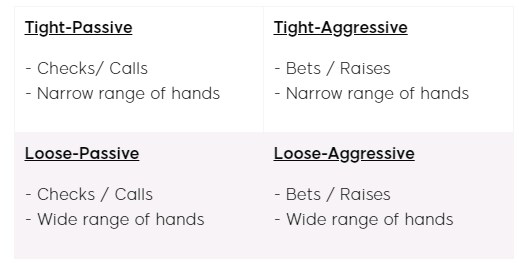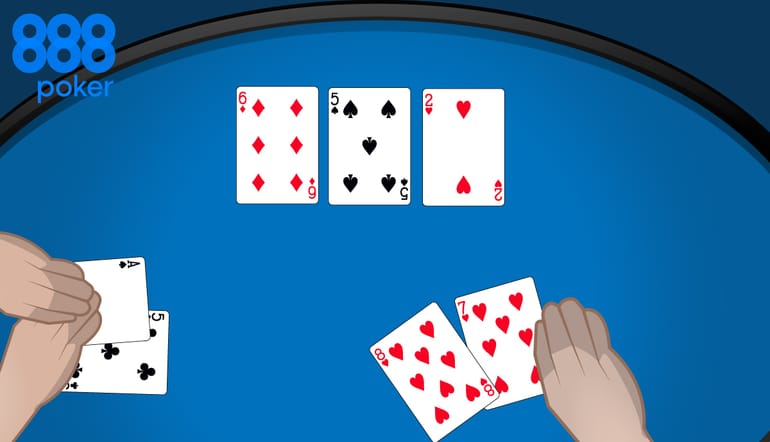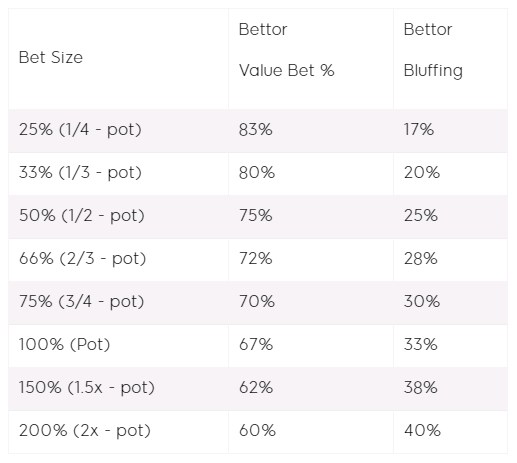The Term Equity in poker, refers to the portion of the pot that should be yours. It’s based on your overall chances of winning the hand at any current point. Simplified, it’s essentially the percentage chance that you’ll win a hand at showdown. A hand’s equity often fluctuates from one street to another as player’s hand gets closer to showdown.
Fold Equity takes the “equity” concept a step further and refers to the amount of equity a player gains in the hand from betting or raising and making their opponent fold.
As an example, let’s suppose Player 1 had 75% equity (chance of winning the hand) on the turn, and Player 2 had 25% equity. If the players were all-in, both players would fully realise their equities, and Player 1 would win the hand 3 out of 4 times.
If Player 1 bets (or raises), though, and makes Player 2 fold, then he gains that 25% equity through fold equity, awarding him the whole pot in its current state!
Table of Contents
- Aggression in Poker: Why Is Fold Equity Important?
- Fold Equity: The Importance of Semi-Bluffing
- Fold Equity: River Bluffs
- The Art of Bluffing: Choosing the Right Bet Size
- The Maths Behind Fold Equity
- Fold Equity Calculators: What It Is and What Metrics To Use
- Fold Equity Calculators: Putting Them Into Use
- Common Situations for Gaining Fold Equity
- Always Remember Player Types: Do You Have Fold Equity?
- Fold Equity Summary
Aggression in Poker: Why Is Fold Equity Important?
Many poker teachings show a 4-quadrant diagram illuminating the generalised styles of different possible poker players:

Best Playing Types In Order:
- Tight-Aggressive
- Loose-Aggressive (but not overly crazy, like a maniac)
- Tight-Passive
- Loose-Passive
You’ll notice that the aggressive players get the nod for ranking in the number #1 and #2 spots, versus the more passive players in #3 and #4. Why is this?
By taking passive betting lines (i.e. checks and calls), the only way that you can win a hand is at showdown, where hands are revealed, and the players still involved have fully realised their hand’s equity.
By taking aggressive betting lines (i.e. bets and raises), you add a way that you can win the hand, and that is by getting your opponent to fold!With this method, it’s not necessary to reach showdown always to have your hand realise its equity.
Instead, by pushing your opponent off their holding, you gain their equity and immediately win the full pot outright!
Fold Equity: The Importance of Semi-Bluffing

Fold equity holds massive power if you’re able to push your opponent off a better hand than your current one. As such, many draws (especially weak ones with no current showdown value) are great options of hands to play aggressively and semi-bluff.
(Semi-Bluff - not having any value now but the potential to improve significantly later to a much stronger hand, like a straight or a flush.)
Imagine this: You open-raise 8-7 suited from the button: the small blind folds, and the big blind calls. The flop comes 6-5-2 rainbow. You bet the flop with your open-ended straight draw and the big blind calls. The turn is a Ten, and you bet again.
Your opponent folds and you win the full pot, denying your opponent from realising his equity and gaining the equity he had in the hand by means of fold equity. Currently, you only had 8-high, meaning that the hand your opponent folded was almost certainly better than yours!
Let’s take a look at some hands that Villain may have folded to the turn barrel and the equity match-ups of your hand vstheirs:
- 87s vs AQo / A2o / A5o: 32% vs 68%
- 87s vs 85s: 18% vs 82%
Think about just how many high-card combos that Villain might “float” the flop with here – a lot being ace-high or broadway combos, like AQo. Now also think about Villain’s marginal made hands he might fold like a pair like 2’s or 5’s.
Against those hands, by betting and getting your opponent to fold, you gain the whopping 68% equity that your opponent otherwise had in the hand! And, if your opponent had something like 85s, you’re gaining a crazy 82% equity from fold equity, if your bet forces him to relinquish his holding!
Therefore, as you can see, betting as a semi-bluff has excellent merit to it! You can either get your opponent to fold now and win the pot or improve your hand later on and have a strong hand at showdown!
Semi-bluff hands (draws) also frequently make for great candidates to balance out a value betting range. For more tips and tricks on semi-bluffing, check out this article, I previously wrote on the topic:
https://www.888poker.com/magazine/strategy/poker-bluff/semi-bluffing
Fold Equity: River Bluffs
Now, this concept of fold equity doesn’t only go for preflop, flop, or turn situations during semi-bluffs – it can be applied on the river, too!
By the river, with no more cards to come, equities have been fully realised, meaning (unless it’s a split pot situation), one player has the best hand (100% to win the pot at showdown), and one player has the worst hand (0% to win at showdown).
Therefore, bluffing on the river can have great benefit, if you can successfully get your opponent to fold! By taking an aggressive line and betting (or raising), you can gain Villain’s entire 100% equity in the pot that they have if you can get them to fold.
As such, fold equity is a MASSIVE concept that can’t go unnoticed! If you can bluff your opponent off a better hand, this can add massive amounts of money to your bottom line!
Now, you can just blindly go bet-bet-bet every hand to try to accomplish this. Otherwise, you open yourself up to exploitation. However, you can use these bluffing tips to help steer you in the right direction for when to choose opportune times to bluff. :)
The Art of Bluffing: Choosing the Right Bet Size
Because equities aren’t fully realised on the flop or the turn when you do opt to bet, the following simplified ratios can be used to help choose which ratio of value hands to bluff hands to bet:
- Flop: 1 value hand: 2 bluffs / semi-bluffs
- Turn: 1 value hand: 1 bluff / semi-bluff
- River: 2 value hands: 1 bluff
Now, for the river, when equities are realised, it’s a lot easier to determine your bet sizing along with the exact number of value and bluff combos you should be betting with, based on that bet size. (This topic and more is covered in my comprehensive article on bet sizing.)
Essentially, on the river, you want to bet with any hand that will beat your opponent more than 50% of the time that they call. (The threshold can increase for tournaments, closer to 60%, because of the high value of trying to keep and preserve your tournament life.) This figure will help you determine the number of value combos you’re betting with, to start out.
Next up is to work out what bet size to use and how many bluffs accordingly you can include into this betting range, to remain balanced and unexploitable. If you want to use a large bet size, you can use more combos of bluffs. If you won’t have many bluffs in your river betting range, you should use a smaller sizing.
Use the following chart we created to help better illustrate the exact ratios:

NOTE: For those curious how we got the numbers, the formula for determining how often you should be bluffing on the river is:
(bet size) / (bet size + money in pot)
For example, if someone bets $25 into a pot of $100 (making the new pot $125), then the formula would be ($25) / ($25 + $125) = 16.6% for the amount of bluffs you should have in an unexploitable river betting range for a 25% pot bet. Then you can just go 100% - 16.6% = ~83% to figure out how many hands in your river betting range should be for value.
How to Calculate Fold Equity
Here’s one formula you can use to help you toy with your overall equity relative to betting and gaining fold equity:
Your Hand’s Current Equity + (% Villain Folds) * (Villain’s Equity) = Your Overall Equity
In other words, if you’re 25% to win the hand, and you think Villain will fold 50% of the time to your bet, then you could calculate a more realistic guess of what your hand’s overall equity would be, taking fold equity into account:
25% + (50%)*(75%) = 62.5% equity
You’ll notice in the example above that your hand’s equity jumped from 25% to 62.5%, just from betting alone!
Of course, the higher the chance that your opponent can find a fold, the more fold equity you’ll have when you bet. And this increased fold equity subsequently would cause your overall equity to increase, too.
Sometimes whether or not your opponent will fold depends on what kind of player type they are, but more on this later!
Fold Equity Calculators: What It Is and What Metrics To Use
Fold equity calculators, like this free tool, help players determine when they go all-in (either as a bet or a raise) how often their opponent must fold for their bet to be + EV, or profitable.
This tool is a particularly useful to use when semi-bluffing with some sort of draw and might commonly be found being done as a flop or turn cbet, as a check-raise (check-jam), or as a bet/ 3bet shove line.
There are four determining metrics used to determine the required “Villain Fold %”:
- Pot Size Before You Shove: This metric accounts for any money already in the middle, in addition to bets/raises in the current round of betting, immediately before you’d jam.
- How Much You Have to Call: This amount refers to the amount you’d have to call to “match” your opponent’s bet in the current betting round. (Leave as “0” if you’re going all-in when first to speak or after your opponent has checked.)
- How Much Are You Shoving Total: The total amount left in your (effective) stack when you’d shove (after any betting you may have already made that round).
- Estimated % Equity When Called: From this, you’d take your hand’s equity vs the range of hands you think your opponent might call you with (NOT just the hands they might currently have). You can use equity calculators like Equilab, Flopzilla, Poker Cruncher, or those found in your poker tracking software to do this calculation.
EXAMPLE: If on the flop the pot is $100, you bet $50, your opponent raises to $150, and you go in for $500 total, the metric for #1 should read ($100 + $150 + $50 = $300), leaving $100 ($150 - $50) for metric $2, and $450 ($500 stack before flop betting - $50 for your initial flop bet) for metric #3.
Fold Equity Calculators: Putting Them Into Use
After doing the required input and calculations in this free fold equity calculator, here’s a trick to put that “fold %” number/answer you get into practical use:
- Take the number of combos you think Villain will call your jam with and multiply it by 1.X, where “X” represents the % time Villain needs to fold (i.e. 25% Villain needs to fold means it’d be 1.25).
- Subtract the value hand combos from the product above.
- If you think Villain will fold that many hand combos at the least, then your shove will be profitable.
Example: Let’s say the calculator says you need Villain to fold 25% of the time when you shove for you to be profitable. You think he’ll call you with 20 combos of hands.
- 20 x 1.25 = 25 combos total
- 25 combos total – 20 calling combos = 5 other combos
- ∴ If you think Villain will fold 5 hands in his range (for however he’s played his hand up until that point), then your shove will be profitable.
The more often you practice using a fold equity calculator for different situations, the more used to the numbers you’ll get and the more adept you’ll become at choosing your semi-bluffing spots appropriately.
Common Situations for Gaining Fold Equity
Any betting line that is either a bet or a raise helps you gain fold equity (assuming your opponent(s) will fold at least some percentage of the time).
Here’s a list of some common places that aggressive betting lines can help you gain fold equity and win pots:
- Preflop Raise (PFR): Limping (just calling the big blind) isn’t a good part of a winning strategy because it doesn’t build a pot, doesn’t gain fold equity. And, it allows the big blind to better realise his equity for free. Coming in for a raise, however, during preflop action means other players might all fold, awarding you an uncontested pot immediately! When you enter a pot, come in for a raise. This PFR is especially valuable and applicable for tournament poker, in the case of open-jamming when short-stacked.
- 3bet+: In the same family of preflop raises comes the additional re-raises+after the initial raise.
- C-Betting: This play is where you raised preflop, and then fire a bet on the flop, too. “Continuation betting” can also be done on later streets, such as when one is double barrelling or triple barrelling (firing consecutive bets on all three post-flop streets). It can also be called a “delayed cbet” if the preflop raiser raises pre, checks through the flop, and then is the one to bet on the turn.
- Probe Betting: This play occurs where another player raises preflop in position, checks back on the flop, and then you (out-of-position) bet the turn. Seeing your opponent didn’t bet the flop could mean they’re weak or haven’t connected well with the board. On the turn, if any cards further connect well with the board, a good-sized probe bet can put pressure on your opponent and may well get folds out of them, too.
- Check-Raising: When you’re out of position in a hand, it can be quite challenging to play draws profitably, especially on the turn. If you just call a turn bet (not getting the right expressed odds, perhaps, but maybe getting the right implied odds), it can still be difficult to get value on the river if you do make your hand. Donk-betting (betting into another player on a later street after another player has had the betting lead) is not so conventional and can also be exploitable and challenging to balance.
Sadly though, if with your draw, you call the turn bet, improve your hand, and then check to your opponent, there’s no guarantee he’ll bet allowing you to get that required river money to make your turn call profitable. Therefore, check-raising out of position with select draws, either on the flop or turn, can help gain you fold equity. It will also help you take the initiative in the hand, allowing you to bluff or value bet later streets if desired (depending on whether or not your draw hits).
Always Remember Player Types: Do You Have Fold Equity?
As aforementioned, the fold equity (and subsequent “overall equity”) that you have in a hand increases when the likelihood of your opponent folding to a bet or raise also increases.
Against particular players types (i.e. nit/weak/passive/straightforward), it can be very advantageous to bet and bluff against them, especially on flops, because of their high likelihood of folding too often.
Against other player types (i.e. like calling stations), one’s fold equity goes down substantially against them because of how infrequently these players fold when facing a bet or a raise.
It’s essential to take your opponent’s exploitative tendencies into account and adjust your game play accordingly when deciding how to construct your betting ranges.
A few other considerations for determining whether or not a bet/raise would have fold equity include:
- One’s stack size relative to the blinds: This factor applies especially in tournaments where players are more prone to open-shoving preflop. If the player in the small blind has 3bb and action folds to him, he likely doesn’t have much fold equity if he jams because of the fantastic price the big blind would be getting to call.
- Pot Odds and Bet Sizing: While not always the case, generally, small bets are called more frequently, and large bets are called more infrequently.
- Effective Stack Sizes: Just because you have $1,000 in a $1/$2 game doesn’t mean everyone else has. Always account for other players’ various stack sizes and how they may change (both in direct size and relative to the size of the pot) from street to street and one action to the next.
Fold Equity Summary
Being aggressive and making other players fold their hands because of the bets or raises you make in poker is a powerful tool to have. You gain an extra way of winning the pot other than just at showdown, and that is by making your opponent(s) fold, awarding you the entirety of the current pot right then and there.
To help further improve your game, be sure to study the above-mentioned supplementary articles on bet sizing, semi-bluffing, and bluffing.These extras will help you understand additional concepts that are very much tied into to that of fold equity, as these aspects deal right in-line with taking aggressive lines.


